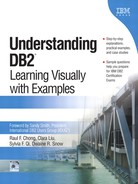Chapter 16
| A1: | Uncommitted read applications acquire an IN lock on the table but no row-level locks. |
| A2: | The maximum requester I/O block size is 64K. |
| A3: | You can configure DB2 to create some agent processes when DB2 is started by setting the NUM_INITAGENTS parameter to a value greater than zero. |
| A4: | To ensure the integrity of your database, DB2 writes the log buffers to disk when:
|
| A5: | Lock escalation will occur when:
|
| A6: | You can capture table and index statistics:
|
| A7: | The reorg command not only reclusters the data in the table, but it also removes embedded free space by deleting rows and eliminating overflow records. |
| A8: | The timestamp monitor switch is enabled by default (it is used by the health monitor). |
| A9: | The reset monitor all command will reset all of the database monitor counters. |
| A10: | You need to create the explain tables to use the Visual Explain tool. |
| A11: | D. The import command cannot capture statistics. |
| A12: | D. The SOFTMAX configuration parameter controls the percentage of a log file that is filled before the page cleaners are triggered to write dirty pages from the buffer pool(s) to disk. |
| A13: | C. When DB2 performs lock escalation, it converts row-level locks to a table-level lock. |
| A14: | B. The configuration parameter sequential detection (SEQ_DETECT) allows DB2 to detect sequential page reads and trigger prefetching. |
| A15: | B and D. The page cleaners are triggered when the percentage of dirty pages in any one buffer pool reaches CHNGPGS_THRESH, or when applications write enough information to the logs to reach SOFTMAX percentage of any log file. |
| A16: | A. reorgchk will indicate if a reorg is suggested based on a number of conditions. One of these conditions is the number of overflow records in the table. |
| A17: | B. An overflow record is created when a row in a table is updated, a varchar column is updated, and its length increases so much that it can no longer fit on the same page. |
| A18: | D. DB2 does not support hints, as they are not needed due to the efficiency of the DB2 optimizer. |
| A19: | D. DTSCAN is not an operator used by DB2. |
| A20: | C. The shared sort heap threshold is a hard limit, and an attempt to start the fourth concurrent shared sort would cause that sort to overflow; therefore, the answer is C. |
..................Content has been hidden....................
You can't read the all page of ebook, please click here login for view all page.
